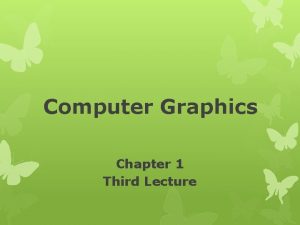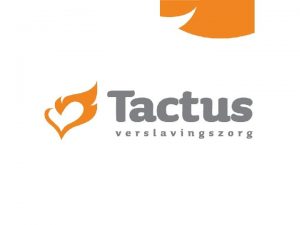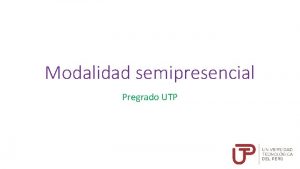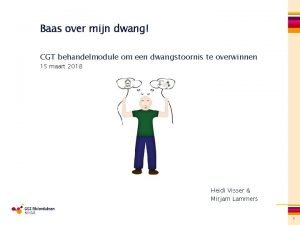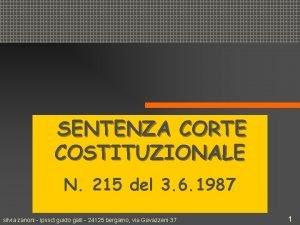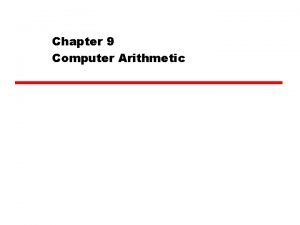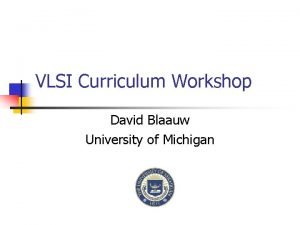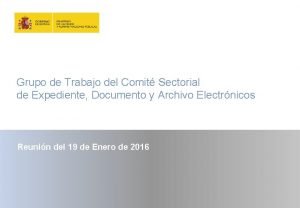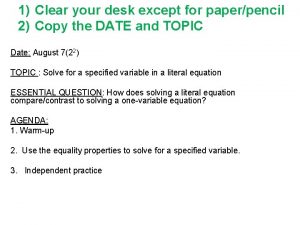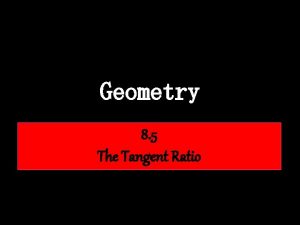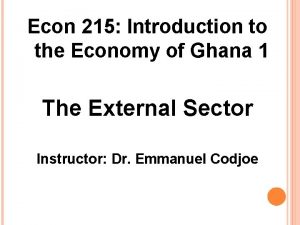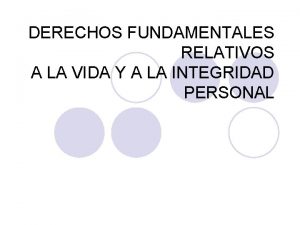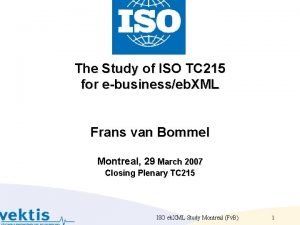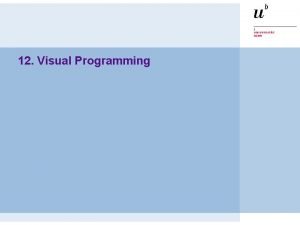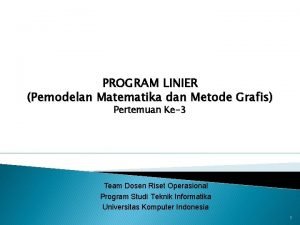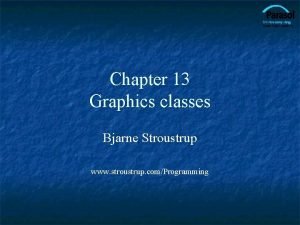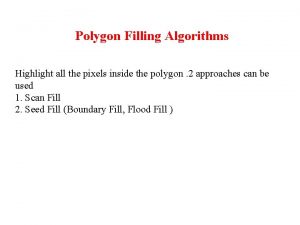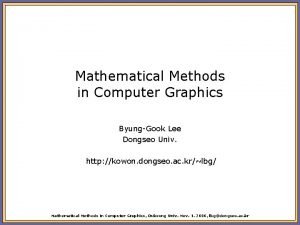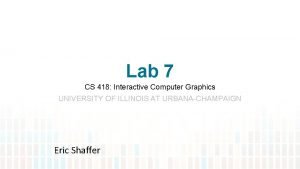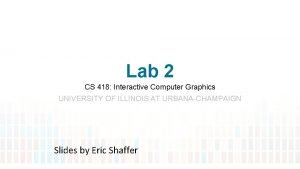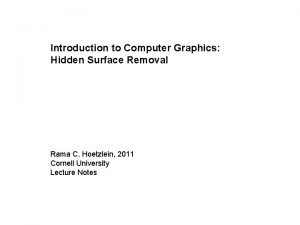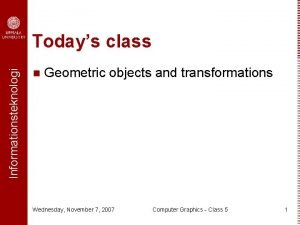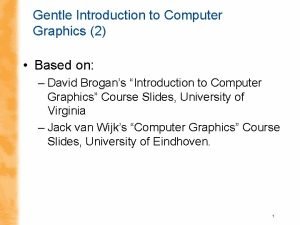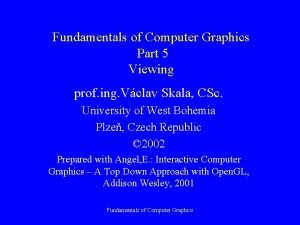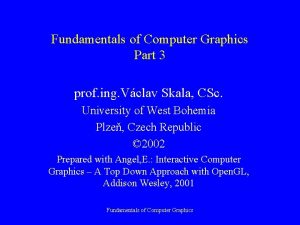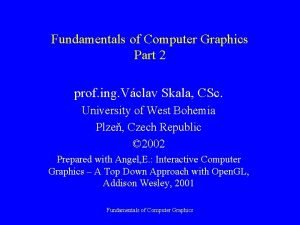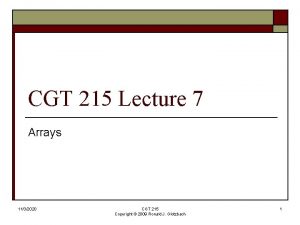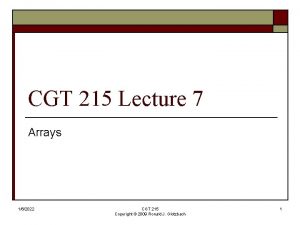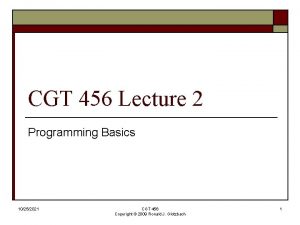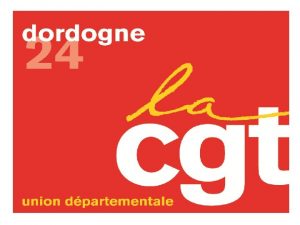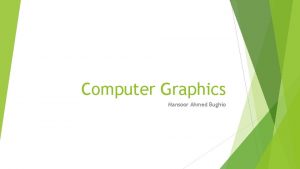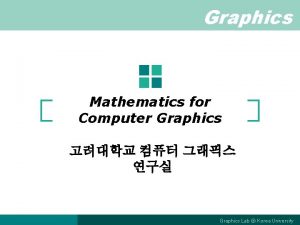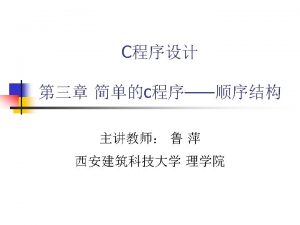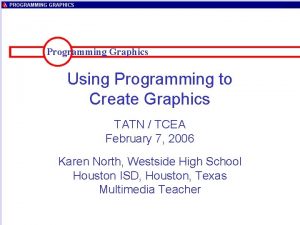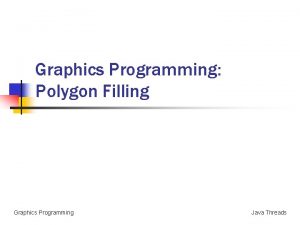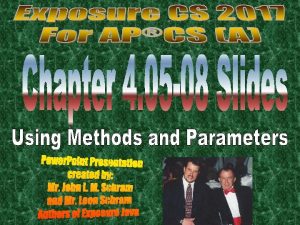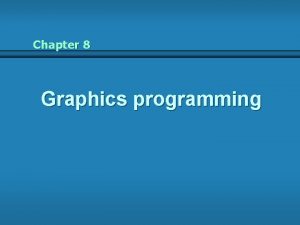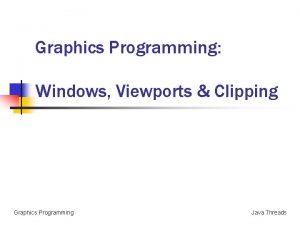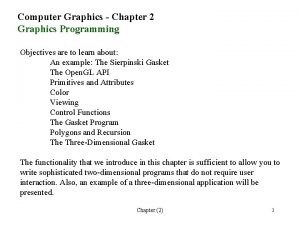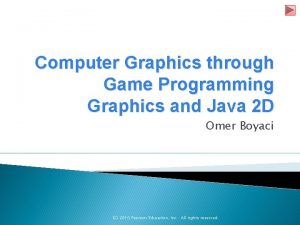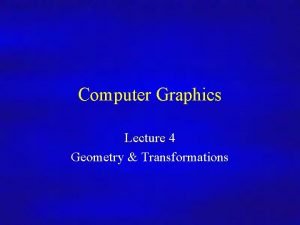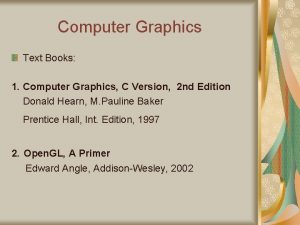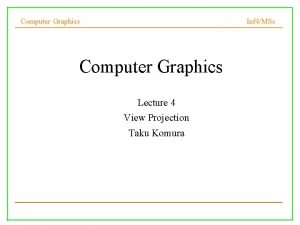CGT 215 Computer Graphics Programming I Intro to

























































- Slides: 57

CGT 215 Computer Graphics Programming I: Intro to C++ © Copyright 1992 -2012 by Pearson Education, Inc. All Rights Reserved; © Copyright 2012 by David Whittinghill, Ph. D. , Bedrich Benes, Ph. D.

© Copyright 1992 -2012 by Pearson Education, Inc. All Rights Reserved; © Copyright 2012 by David Whittinghill, Ph. D. , Bedrich Benes, Ph. D.

© Copyright 1992 -2012 by Pearson Education, Inc. All Rights Reserved; © Copyright 2012 by David Whittinghill, Ph. D. , Bedrich Benes, Ph. D.

2. 1 Introduction We now introduce C++ programming, which facilitates a disciplined approach to program design. Most of the C++ programs you’ll study in this book process information and display results. © Copyright 1992 -2012 by Pearson Education, Inc. All Rights Reserved; © Copyright 2012 by David Whittinghill, Ph. D. , Bedrich Benes, Ph. D.

2. 2 First Program in C++: Printing a Line of Text Simple program that prints a line of text (Fig. 2. 1). © Copyright 1992 -2012 by Pearson Education, Inc. All Rights Reserved; © Copyright 2012 by David Whittinghill, Ph. D. , Bedrich Benes, Ph. D.

© Copyright 1992 -2012 by Pearson Education, Inc. All Rights Reserved; © Copyright 2012 by David Whittinghill, Ph. D. , Bedrich Benes, Ph. D.

2. 2 First Program in C++: Printing a Line of Text (cont. ) // indicates that the remainder of each line is a comment. ◦ You insert comments to document your programs and to help other people read and understand them. ◦ Comments are ignored by the C++ compiler and do not cause any machine-language object code to be generated. A comment beginning with // is called a single-line comment because it terminates at the end of the current line. You also may use C’s style in which a comment— possibly containing many lines—begins with /* and ends with */. © Copyright 1992 -2012 by Pearson Education, Inc. All Rights Reserved; © Copyright 2012 by David Whittinghill, Ph. D. , Bedrich Benes, Ph. D.

© Copyright 1992 -2012 by Pearson Education, Inc. All Rights Reserved; © Copyright 2012 by David Whittinghill, Ph. D. , Bedrich Benes, Ph. D.

2. 2 First Program in C++: Printing a Line of Text (cont. ) A preprocessor directive is a message to the C++ preprocessor. Lines that begin with # are processed by the preprocessor before the program is compiled. #include <iostream> notifies the preprocessor to include in the program the contents of the input/output stream header file <iostream>. ◦ Must be included for any program that outputs data to the screen or inputs data from the keyboard using C++-style stream input/output. © Copyright 1992 -2012 by Pearson Education, Inc. All Rights Reserved; © Copyright 2012 by David Whittinghill, Ph. D. , Bedrich Benes, Ph. D.

© Copyright 1992 -2012 by Pearson Education, Inc. All Rights Reserved; © Copyright 2012 by David Whittinghill, Ph. D. , Bedrich Benes, Ph. D.

2. 2 First Program in C++: Printing a Line of Text (cont. ) You use blank lines, space characters and tab characters (i. e. , “tabs”) to make programs easier to read. ◦ Together, these characters are known as white space. ◦ White-space characters are normally ignored by the compiler. © Copyright 1992 -2012 by Pearson Education, Inc. All Rights Reserved; © Copyright 2012 by David Whittinghill, Ph. D. , Bedrich Benes, Ph. D.

2. 2 First Program in C++: Printing a Line of Text (cont. ) main is a part of every C++ program. The parentheses after main indicate that main is a program building block called a function. C++ programs typically consist of one or more functions and classes. Exactly one function in every program must be named main. C++ programs begin executing at function main, even if main is not the first function in the program. The keyword int to the left of main indicates that main “returns” an integer (whole number) value. ◦ A keyword is a word in code that is reserved by C++ for a specific use. ◦ For now, simply include the keyword int to the left of main in each of your programs. © Copyright 1992 -2012 by Pearson Education, Inc. All Rights Reserved; © Copyright 2012 by David Whittinghill, Ph. D. , Bedrich Benes, Ph. D.

2. 2 First Program in C++: Printing a Line of Text (cont. ) A left brace, {, must begin the body of every function. A corresponding right brace, }, must end each function’s body. A statement instructs the computer to perform an action. A string is sometimes called a character string or a string literal. We refer to characters between double quotation marks simply as strings. ◦ White-space characters in strings are not ignored by the compiler. A statement normally ends with a semicolon (; ), also known as the statement terminator. ◦ Preprocessor directives (like #include) do not end with a semicolon. © Copyright 1992 -2012 by Pearson Education, Inc. All Rights Reserved; © Copyright 2012 by David Whittinghill, Ph. D. , Bedrich Benes, Ph. D.

2. 2 First Program in C++: Printing a Line of Text (cont. ) When a cout statement executes, it sends a stream of characters to the standard output stream object—std: : cout—which is normally “connected” to the screen. The std: : before cout is required when we use names that we’ve brought into the program by the preprocessor directive #include <iostream>. ◦ The notation std: : cout specifies that we are using a name, in this case cout, that belongs to “namespace” std. ◦ The names cin (the standard input stream) and cerr (the standard error stream) also belong to namespace std. The << operator is referred to as the stream insertion operator. ◦ The value to the operator’s right, the right operand, is inserted in the output stream. © Copyright 1992 -2012 by Pearson Education, Inc. All Rights Reserved; © Copyright 2012 by David Whittinghill, Ph. D. , Bedrich Benes, Ph. D.

© Copyright 1992 -2012 by Pearson Education, Inc. All Rights Reserved; © Copyright 2012 by David Whittinghill, Ph. D. , Bedrich Benes, Ph. D.

2. 2 First Program in C++: Printing a Line of Text (cont. ) The characters n are not printed on the screen. The backslash () is called an escape character. ◦ It indicates that a “special” character is to be output. When a backslash is encountered in a string of characters, the next character is combined with the backslash to form an escape sequence. The escape sequence n means newline. ◦ Causes the cursor to move to the beginning of the next line on the screen. When the return statement is used at the end of main the value 0 indicates that the program has terminated successfully. According to the C++ standard, if program execution reaches the end of main without encountering a return statement, it’s assumed that the program terminated successfully—exactly as when the last statement in main is a return statement with the value 0. © Copyright 1992 -2012 by Pearson Education, Inc. All Rights Reserved; © Copyright 2012 by David Whittinghill, Ph. D. , Bedrich Benes, Ph. D.

© Copyright 1992 -2012 by Pearson Education, Inc. All Rights Reserved; © Copyright 2012 by David Whittinghill, Ph. D. , Bedrich Benes, Ph. D.

2. 3 Modifying Our First C++ Program Welcome to C++! can be printed several ways. © Copyright 1992 -2012 by Pearson Education, Inc. All Rights Reserved; © Copyright 2012 by David Whittinghill, Ph. D. , Bedrich Benes, Ph. D.

© Copyright 1992 -2012 by Pearson Education, Inc. All Rights Reserved; © Copyright 2012 by David Whittinghill, Ph. D. , Bedrich Benes, Ph. D.

2. 3 Modifying Our First C++ Program (cont. ) A single statement can print multiple lines by using newline characters. Each time the n (newline) escape sequence is encountered in the output stream, the screen cursor is positioned to the beginning of the next line. To get a blank line in your output, place two newline characters back to back. © Copyright 1992 -2012 by Pearson Education, Inc. All Rights Reserved; © Copyright 2012 by David Whittinghill, Ph. D. , Bedrich Benes, Ph. D.

© Copyright 1992 -2012 by Pearson Education, Inc. All Rights Reserved; © Copyright 2012 by David Whittinghill, Ph. D. , Bedrich Benes, Ph. D.

2. 4 Another C++ Program: Adding Integers The input stream object std: : cin and the stream extraction operator-, >>, can be used obtain data from the user at the keyboard. © Copyright 1992 -2012 by Pearson Education, Inc. All Rights Reserved; © Copyright 2012 by David Whittinghill, Ph. D. , Bedrich Benes, Ph. D.

© Copyright 1992 -2012 by Pearson Education, Inc. All Rights Reserved; © Copyright 2012 by David Whittinghill, Ph. D. , Bedrich Benes, Ph. D.

© Copyright 1992 -2012 by Pearson Education, Inc. All Rights Reserved; © Copyright 2012 by David Whittinghill, Ph. D. , Bedrich Benes, Ph. D.

2. 4 Another C++ Program: Adding Integers (cont. ) Declarations introduce identifiers into programs. The identifiers number 1, number 2 and sum are the names of variables. A variable is a location in the computer’s memory where a value can be stored for use by a program. Variables number 1, number 2 and sum are data of type int, meaning that these variables will hold integer values, i. e. , whole numbers such as 7, – 11, 0 and 31914. All variables must be declared with a name and a data type before they can be used in a program. If more than one name is declared in a declaration (as shown here), the names are separated by commas (, ); this is referred to as a comma-separated list. © Copyright 1992 -2012 by Pearson Education, Inc. All Rights Reserved; © Copyright 2012 by David Whittinghill, Ph. D. , Bedrich Benes, Ph. D.

2. 4 Another C++ Program: Adding Integers (cont. ) Data type double is for specifying real numbers, and data type char for specifying character data. Real numbers are numbers with decimal points, such as 3. 4, 0. 0 and – 11. 19. A char variable may hold only a single lowercase letter, a single uppercase letter, a single digit or a single special character (e. g. , $ or *). Types such as int, double and char are called fundamental types. Fundamental-type names are keywords and therefore must appear in all lowercase letters. Appendix C contains the complete list of fundamental types. © Copyright 1992 -2012 by Pearson Education, Inc. All Rights Reserved; © Copyright 2012 by David Whittinghill, Ph. D. , Bedrich Benes, Ph. D.

2. 4 Another C++ Program: Adding Integers (cont. ) A variable name is any valid identifier that is not a keyword. An identifier is a series of characters consist-ing of letters, digits and underscores ( _ ) that does not begin with a digit. C++ is case sensitive—uppercase and lowercase letters are different, so a 1 and A 1 are different identifiers. © Copyright 1992 -2012 by Pearson Education, Inc. All Rights Reserved; © Copyright 2012 by David Whittinghill, Ph. D. , Bedrich Benes, Ph. D.

© Copyright 1992 -2012 by Pearson Education, Inc. All Rights Reserved; © Copyright 2012 by David Whittinghill, Ph. D. , Bedrich Benes, Ph. D.

© Copyright 1992 -2012 by Pearson Education, Inc. All Rights Reserved; © Copyright 2012 by David Whittinghill, Ph. D. , Bedrich Benes, Ph. D.

2. 4 Another C++ Program: Adding Integers (cont. ) Declarations of variables can be placed almost anywhere in a program, but they must appear before their corresponding variables are used in the program. © Copyright 1992 -2012 by Pearson Education, Inc. All Rights Reserved; © Copyright 2012 by David Whittinghill, Ph. D. , Bedrich Benes, Ph. D.

2. 4 Another C++ Program: Adding Integers (cont. ) A prompt it directs the user to take a specific action. A cin statement uses the input stream object cin (of namespace std) and the stream extraction operator, >>, to obtain a value from the keyboard. Using the stream extraction operator with std: : cin takes character input from the standard input stream, which is usually the keyboard. © Copyright 1992 -2012 by Pearson Education, Inc. All Rights Reserved; © Copyright 2012 by David Whittinghill, Ph. D. , Bedrich Benes, Ph. D.

2. 4 Another C++ Program: Adding Integers (cont. ) When the computer executes an input statement that places a value in an int variable, it waits for the user to enter a value for variable number 1. The user responds by typing the number (as characters) then pressing the Enter key (sometimes called the Return key) to send the characters to the computer. The computer converts the character representation of the number to an integer and assigns (i. e. , copies) this number (or value) to the variable number 1. Any subsequent references to number 1 in this program will use this same value. In this program, an assignment statement adds the values of variables number 1 and number 2 and assigns the result to variable sum using the assignment operator =. ◦ Most calculations are performed in assignment statements. © Copyright 1992 -2012 by Pearson Education, Inc. All Rights Reserved; © Copyright 2012 by David Whittinghill, Ph. D. , Bedrich Benes, Ph. D.

2. 4 Another C++ Program: Adding Integers (cont. ) The = operator and the + operator are called binary operators because each has two operands. © Copyright 1992 -2012 by Pearson Education, Inc. All Rights Reserved; © Copyright 2012 by David Whittinghill, Ph. D. , Bedrich Benes, Ph. D.

2. 4 Another C++ Program: Adding Integers (cont. ) std: : endl is a so-called stream manipulator. The name endl is an abbreviation for “end line” and belongs to namespace std. The std: : endl stream manipulator outputs a newline, then “flushes the output buffer. ” ◦ This simply means that, on some systems where outputs accumulate in the machine until there are enough to “make it worthwhile” to display them on the screen, std: : endl forces any accumulated outputs to be displayed at that moment. ◦ This can be important when the outputs are prompting the user for an action, such as entering data. © Copyright 1992 -2012 by Pearson Education, Inc. All Rights Reserved; © Copyright 2012 by David Whittinghill, Ph. D. , Bedrich Benes, Ph. D.

2. 4 Another C++ Program: Adding Integers (cont. ) Using multiple stream insertion operators (<<) in a single statement is referred to as concatenating, chaining or cascading stream insertion operations. Calculations can also be performed in output statements. © Copyright 1992 -2012 by Pearson Education, Inc. All Rights Reserved; © Copyright 2012 by David Whittinghill, Ph. D. , Bedrich Benes, Ph. D.

2. 5 Memory Concepts Variable names such as number 1, number 2 and sum actually correspond to locations in the computer’s memory. Every variable has a name, a type, a size and a value. When a value is placed in a memory location, the value overwrites the previous value in that location; thus, placing a new value into a memory location is said to be destructive. When a value is read out of a memory loca-tion, the process is nondestructive. © Copyright 1992 -2012 by Pearson Education, Inc. All Rights Reserved; © Copyright 2012 by David Whittinghill, Ph. D. , Bedrich Benes, Ph. D.

© Copyright 1992 -2012 by Pearson Education, Inc. All Rights Reserved; © Copyright 2012 by David Whittinghill, Ph. D. , Bedrich Benes, Ph. D.

© Copyright 1992 -2012 by Pearson Education, Inc. All Rights Reserved; © Copyright 2012 by David Whittinghill, Ph. D. , Bedrich Benes, Ph. D.

© Copyright 1992 -2012 by Pearson Education, Inc. All Rights Reserved; © Copyright 2012 by David Whittinghill, Ph. D. , Bedrich Benes, Ph. D.

2. 6 Arithmetic Most programs perform arithmetic calculations. Figure 2. 9 summarizes the C++ arithmetic operators. The asterisk (*) indicates multiplication. The percent sign (%) is the modulus operator that will be discussed shortly. ◦ C++ provides the modulus operator, %, that yields the remainder after integer division. ◦ The modulus operator can be used only with integer operands. The arithmetic operators in Fig. 2. 9 are all binary operators. Integer division (i. e. , where both the numerator and the denominator are integers) yields an integer quotient. ◦ Any fractional part in integer division is discarded (i. e. , truncated)— no rounding occurs. © Copyright 1992 -2012 by Pearson Education, Inc. All Rights Reserved; © Copyright 2012 by David Whittinghill, Ph. D. , Bedrich Benes, Ph. D.

© Copyright 1992 -2012 by Pearson Education, Inc. All Rights Reserved; © Copyright 2012 by David Whittinghill, Ph. D. , Bedrich Benes, Ph. D.

2. 6 Arithmetic (cont. ) Arithmetic expressions in C++ must be entered into the computer in straight-line form. Expressions such as “a divided by b” must be written as a / b, so that all constants, variables and operators appear in a straight line. Parentheses are used in C++ expressions in the same manner as in algebraic expressions. For example, to multiply a times the quantity b + c we write a a * ( b + c ). © Copyright 1992 -2012 by Pearson Education, Inc. All Rights Reserved; © Copyright 2012 by David Whittinghill, Ph. D. , Bedrich Benes, Ph. D.

2. 6 Arithmetic (cont. ) C++ applies the operators in arithmetic expressions in a precise sequence determined by the following rules of operator precedence, which are generally the same as those followed in algebra. © Copyright 1992 -2012 by Pearson Education, Inc. All Rights Reserved; © Copyright 2012 by David Whittinghill, Ph. D. , Bedrich Benes, Ph. D.

© Copyright 1992 -2012 by Pearson Education, Inc. All Rights Reserved; © Copyright 2012 by David Whittinghill, Ph. D. , Bedrich Benes, Ph. D.

2. 6 Arithmetic (cont. ) There is no arithmetic operator for exponentiation in C++, so x 2 is represented as x * x. Figure 2. 11 illustrates the order in which the operators in a second-degree polynomial are applied. As in algebra, it’s acceptable to place unnecessary parentheses in an expression to make the expression clearer. These are called redundant parentheses. © Copyright 1992 -2012 by Pearson Education, Inc. All Rights Reserved; © Copyright 2012 by David Whittinghill, Ph. D. , Bedrich Benes, Ph. D.

© Copyright 1992 -2012 by Pearson Education, Inc. All Rights Reserved; © Copyright 2012 by David Whittinghill, Ph. D. , Bedrich Benes, Ph. D.

2. 7 Decision Making: Equality and Relational Operators The if statement allows a program to take alternative action based on whether a condition is true or false. If the condition is true, the statement in the body of the if statement is executed. If the condition is false, the body statement is not executed. Conditions in if statements can be formed by using the equality operators and relational operators summarized in Fig. 2. 12. The relational operators all have the same level of precedence and associate left to right. The equality operators both have the same level of precedence, which is lower than that of the relational operators, and associate left to right. © Copyright 1992 -2012 by Pearson Education, Inc. All Rights Reserved; © Copyright 2012 by David Whittinghill, Ph. D. , Bedrich Benes, Ph. D.

© Copyright 1992 -2012 by Pearson Education, Inc. All Rights Reserved; © Copyright 2012 by David Whittinghill, Ph. D. , Bedrich Benes, Ph. D.

2. 7 Decision Making: Equality and Relational Operators (cont. ) The following example uses six if statements to compare two numbers input by the user. If the condition in any of these if statements is satisfied, the output statement as-sociated with that if statement is executed. Figure 2. 13 shows the program and the input/output dialogs of three sample executions. © Copyright 1992 -2012 by Pearson Education, Inc. All Rights Reserved; © Copyright 2012 by David Whittinghill, Ph. D. , Bedrich Benes, Ph. D.

© Copyright 1992 -2012 by Pearson Education, Inc. All Rights Reserved; © Copyright 2012 by David Whittinghill, Ph. D. , Bedrich Benes, Ph. D.

© Copyright 1992 -2012 by Pearson Education, Inc. All Rights Reserved; © Copyright 2012 by David Whittinghill, Ph. D. , Bedrich Benes, Ph. D.

© Copyright 1992 -2012 by Pearson Education, Inc. All Rights Reserved; © Copyright 2012 by David Whittinghill, Ph. D. , Bedrich Benes, Ph. D.

2. 7 Decision Making: Equality and Relational Operators (cont. ) using declarations that eliminate the need to repeat the std: : prefix as we did in earlier programs. Once we insert these using declarations, we can write cout instead of std: : cout, cin instead of std: : cin and endl instead of std: : endl, respectively, in the remainder of the program. Many programmers prefer to use the declaration using namespace std; which enables a program to use all the names in any standard C++ header file (such as <iostream>) that a program might include. From this point forward in the book, we’ll use the preceding declaration in our programs. © Copyright 1992 -2012 by Pearson Education, Inc. All Rights Reserved; © Copyright 2012 by David Whittinghill, Ph. D. , Bedrich Benes, Ph. D.

2. 7 Decision Making: Equality and Relational Operators (cont. ) Each if statement in Fig. 2. 13 has a single statement in its body and each body statement is indented. In Chapter 4 we show to specify if statements with multiple-statement bodies (by enclosing the body statements in a pair of braces, { }, creating what’s called a compound statement or a block). © Copyright 1992 -2012 by Pearson Education, Inc. All Rights Reserved; © Copyright 2012 by David Whittinghill, Ph. D. , Bedrich Benes, Ph. D.

2. 7 Decision Making: Equality and Relational Operators (cont. ) Statements may be split over several lines and may be spaced according to your prefer-ences. It’s a syntax error to split identifiers, strings (such as "hello") and constants (such as the number 1000) over several lines. © Copyright 1992 -2012 by Pearson Education, Inc. All Rights Reserved; © Copyright 2012 by David Whittinghill, Ph. D. , Bedrich Benes, Ph. D.

2. 7 Decision Making: Equality and Relational Operators (cont. ) Figure 2. 14 shows the precedence and associativity of the operators introduced in this chapter. The operators are shown top to bottom in decreasing order of precedence. All these operators, with the exception of the assignment operator =, associate from left to right. © Copyright 1992 -2012 by Pearson Education, Inc. All Rights Reserved; © Copyright 2012 by David Whittinghill, Ph. D. , Bedrich Benes, Ph. D.

© Copyright 1992 -2012 by Pearson Education, Inc. All Rights Reserved; © Copyright 2012 by David Whittinghill, Ph. D. , Bedrich Benes, Ph. D.
 Most of the graphics monitors today operate as
Most of the graphics monitors today operate as Graphics hardware in computer graphics ppt
Graphics hardware in computer graphics ppt Programming raster display system in computer graphics
Programming raster display system in computer graphics Polygebruiker
Polygebruiker Cgt educ versailles
Cgt educ versailles Modalidad cgt utp
Modalidad cgt utp Cgt
Cgt Gedragsexperiment cgt
Gedragsexperiment cgt Sentenza 215/87
Sentenza 215/87 Completed ics 215 form
Completed ics 215 form Http //servsoc/inicio.aspx
Http //servsoc/inicio.aspx Health partners hp connect
Health partners hp connect 10000000/215
10000000/215 Umich vlsi
Umich vlsi Ley 40/215
Ley 40/215 The formula c=5p+215 relates c
The formula c=5p+215 relates c Work physics definition
Work physics definition Dtu-215
Dtu-215 Tangent ratio geometry
Tangent ratio geometry Economic 215
Economic 215 Guggisberg 10 year development plan
Guggisberg 10 year development plan Stc 215/1994
Stc 215/1994 Iso tc 215
Iso tc 215 Round 246 to the nearest ten
Round 246 to the nearest ten Realitykit example
Realitykit example Metode grafis
Metode grafis Programming graphics
Programming graphics Perbedaan linear programming dan integer programming
Perbedaan linear programming dan integer programming Greedy algorithm vs dynamic programming
Greedy algorithm vs dynamic programming System programming
System programming Linear vs integer programming
Linear vs integer programming Definisi linear
Definisi linear Angel
Angel Define viewing in computer graphics
Define viewing in computer graphics Plasma panel in computer graphics
Plasma panel in computer graphics In two dimensional viewing we have?
In two dimensional viewing we have? Shear transformation in computer graphics
Shear transformation in computer graphics Glsl asin
Glsl asin Scan conversion of ellipse
Scan conversion of ellipse Equation of motion of a rotating rigid body
Equation of motion of a rotating rigid body The region of
The region of Starburst method
Starburst method Polygon filling algorithm in computer graphics
Polygon filling algorithm in computer graphics Raster and random scan
Raster and random scan Computer graphics
Computer graphics Line drawing of computer
Line drawing of computer Cs 418 interactive computer graphics
Cs 418 interactive computer graphics Cs 418 interactive computer graphics
Cs 418 interactive computer graphics Hidden surface removal adalah
Hidden surface removal adalah Achromatic light in computer graphics
Achromatic light in computer graphics What is interactive input
What is interactive input Uniform scaling in computer graphics
Uniform scaling in computer graphics Uniform scaling in computer graphics
Uniform scaling in computer graphics Orthogonal projection in computer graphics
Orthogonal projection in computer graphics Logical input devices in computer graphics
Logical input devices in computer graphics Sierpinski gasket in computer graphics
Sierpinski gasket in computer graphics Polygon clipping in computer graphics ppt
Polygon clipping in computer graphics ppt Computer graphics chapter 1 ppt
Computer graphics chapter 1 ppt


